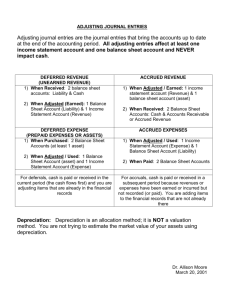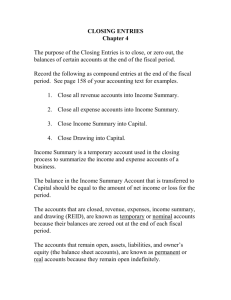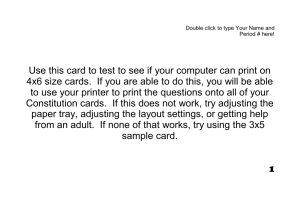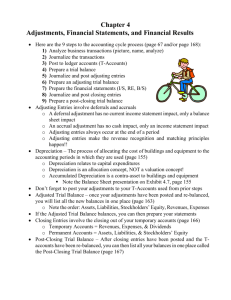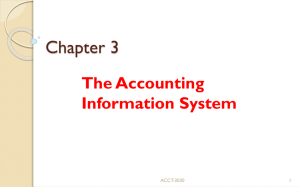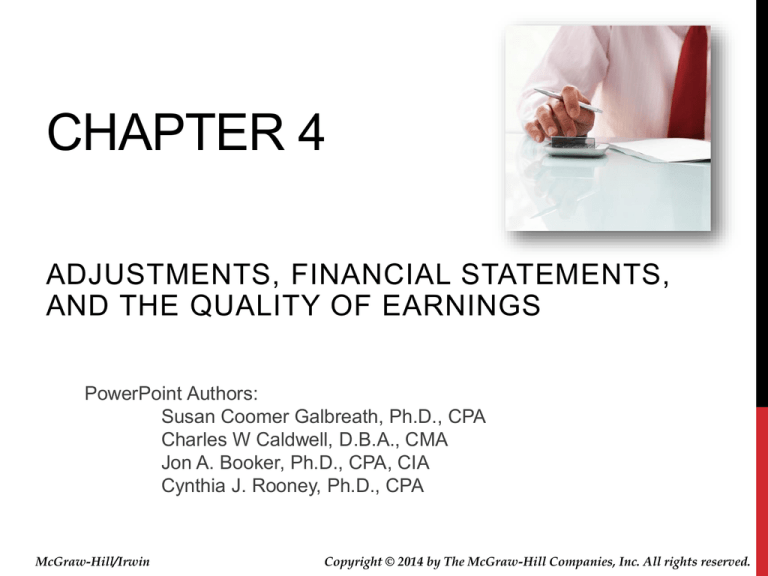
CHAPTER 4
ADJUSTMENTS, FINANCIAL STATEMENTS,
AND THE QUALITY OF EARNINGS
PowerPoint Authors:
Susan Coomer Galbreath, Ph.D., CPA
Charles W Caldwell, D.B.A., CMA
Jon A. Booker, Ph.D., CPA, CIA
Cynthia J. Rooney, Ph.D., CPA
McGraw-Hill/Irwin
Copyright © 2014 by The McGraw-Hill Companies, Inc. All rights reserved.
UNDERSTANDING THE BUSINESS
Management is
responsible for
preparing . . .
Financial
Statements
High Quality =
Relevance +
Reliability
. . . useful to
investors and
creditors.
4-2
ACCOUNTING CYCLE
4-3
UNADJUSTED TRIAL BALANCE
A listing of individual accounts, usually
in financial statement order.
Ending debit or credit balances are
listed in two separate columns.
Total debit account balances should
equal total credit account balances.
4-4
FOUR TYPES OF ADJUSTMENTS
4-5
ADJUSTING ENTRIES
How does the accounting system record revenues and expenses when one
transaction is needed to record a cash receipt or payment and another
transaction is needed to record revenue when it is earned or an expense when it
is incurred? The solution to the problem created by such differences in timing is
to record adjusting entries at the end of every accounting period, so that:
1. Revenues are recorded when they are earned (the revenue realization
principle),
2. Expenses are recorded when they are incurred to generate revenue (the
expense matching principle),
3. Assets are reported at amounts that represent the probable future benefits
remaining at the end of the period, and
4. Liabilities are reported at amounts that represent the probable future
sacrifices of assets or services owed at the end of the period.
Companies wait until the end of the accounting period to adjust their accounts in
this way because adjusting the records daily would be very costly and timeconsuming. Adjusting entries are required every time a company wants to
prepare financial statements for external users.
4-6
ADJUSTMENT PROCESS
In analyzing adjustments at the end of the period, there are three steps:
Step 1: Ask: Was revenue earned or an expense incurred that is not yet
recorded?
If the answer is YES, credit the revenue account or debit the expense
account in the adjusting entry.
Step 2: Ask: Was the related cash received or paid in the past or will it
be received or paid in the future?
If cash was received in the past, a deferred revenue (liability) account was
recorded in the past → Now, reduce the liability account that was recorded
when cash was received.
If cash will be received in the future → Increase the receivable account to
record what is owed by others to the company.
If cash was paid in the past, a deferred expense account was created in the
past → Now reduce the asset account.
If cash will be paid in the future → Increase the payable account to record
what is owed by the company to others.
Step 3: Compute the amount of revenue earned or expense incurred.
Sometimes the amount is given or known, sometimes it must be computed,
and sometimes it must be estimated.
4-7
SUMMARY
In summary, the pattern that results when the adjusting entry is
recorded is as follows:
4-8
4-9
TYPES OF ADJUSTMENTS
4-10
A QUESTION OF ETHICS
4-11
PREPARING FINANCIAL
STATEMENTS
4-12
RELATIONSHIPS OF FINANCIALS
4-13
EARNINGS PER SHARE
You will note that the earnings (EPS) ratio is reported on the income
statement. It is widely used in evaluating the operating performance and
profitability of a company.
Earnings
Per =
Share
Net Income
Average Number of Common Shares Outstanding**
during the Period
**Outstanding shares are those that are currently held by the shareholders.
4-14
FOCUS ON CASH FLOWS
As presented in the previous chapters, the statement of cash
flows explains the difference between the ending and beginning
balances in the Cash Account on the balance sheet during the
accounting period. Put simply, the cash flow statement is a
categorized list of all transactions of the period that affected the
Cash account. The three categories are operating, investing,
and financing activities. Since no adjustments made in this
chapter affected cash, the cash flow categories identified on the
Cash T-account at the end of Chapter 3 remain the same. Many
standard financial analysis texts warn analysts to look for
unusual deferrals and accruals when they attempt to predict
future periods’ earnings. They often suggest that wide
disparities between net income and cash flow from operations
are a useful warning sign.
4-15
TOTAL ASSET TURNOVER RATIO
The ratio helps us determine how efficient
management is in using assets (its
resources) to generate sales.
4-16
CLOSING THE BOOKS
Closing entries:
Even though the
balance sheet account 1. Transfer net income (or
loss) to Retained
balances carry forward
Earnings.
from period to period,
the income statement 2. Establish a zero balance
in each of the temporary
accounts do not.
accounts to start the next
accounting period.
4-17
END OF CHAPTER 4
4-18


